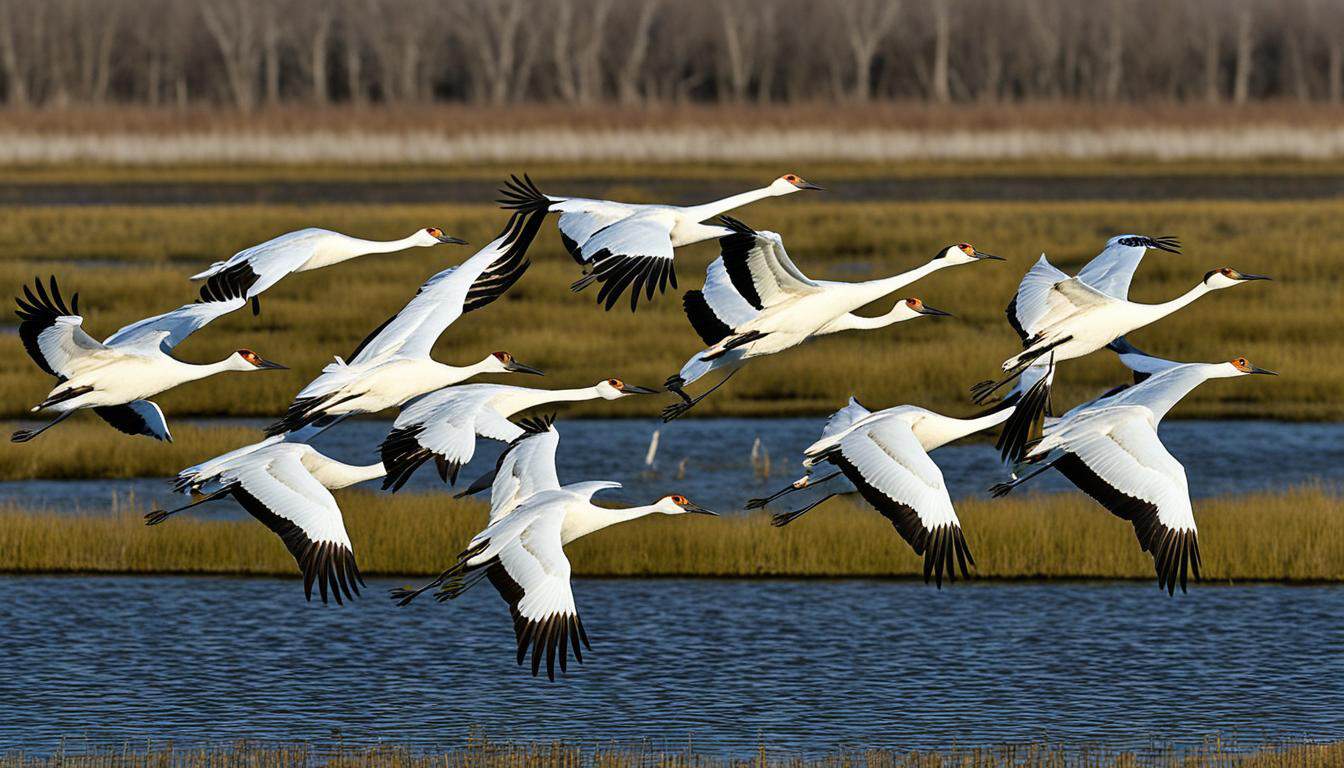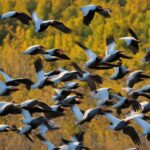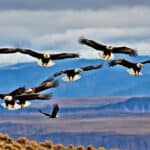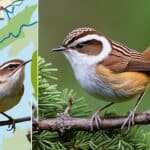The whooping crane’s migration is truly remarkable, showing how they adapt to different environments. These birds travel from Canada to Texas, a long journey just for winter. Some groups go from Wisconsin to Florida with the help of ultralight aircraft. Across the world in Florida and Louisiana, some birds don’t move at all.
This migration isn’t just about flying. It shows how whooping cranes both adapt to nature and need human help to survive. Knowing about their movements helps us strengthen the support we give them.
Introduction to the Whooping Crane
The whooping crane is a majestic bird in North America. It’s known for its large size and beauty. Standing at 5 feet tall, it has a wingspan of over 7 feet. This makes it easy to spot.
Physical Characteristics of Whooping Cranes
Whooping cranes have white feathers with black wingtips and a red crown. This makes them stand out. Adults have yellow eyes. Young whooping cranes have cinnamon-colored feathers and blue eyes. These features show how they’ve adapted to wetland habitats.
Historical Population Decline
The whooping crane faced near-extinction due to habitat loss and overhunting. By the 1940s, their numbers were very low. But, through conservation efforts, they’ve started to recover. Habitat protection and breeding programs are key to their survival. The successful reintroduction of a population in Wisconsin shows hope for their future.
Migration Patterns of the Whooping Crane
The whooping crane has several migration paths, each with its own features. These paths are vital for their survival. They show how the birds use their instincts and the help they get to live.
Canada to Texas Migration Route
The journey from Canada to Texas is key for many whooping cranes. It shows their strength and ability to find the way. Efforts to keep their route clear and safe underline its importance.
Wisconsin to Florida Reintroduction
The story of moving whooping cranes from Wisconsin to Florida is special. It’s done with the aid of small aircraft. This work is a great success in saving the cranes.
Non-migratory Populations in Florida and Louisiana
In Florida and Louisiana, some whooping cranes don’t migrate. They were helped to live there and not move far like others. This teaches us new things about these amazing birds.
Tracking Whooping Crane Movements
Tracking whooping cranes is vital for their conservation. By using GPS and bands, we learn a lot about their travels. This data helps us protect their paths and living spaces.
GPS Tracking and Banding
GPS tracking and banding are key to following whooping cranes. We attach special devices and bands to these birds. This way, we can see where they go, where they stop, and what areas they use.
Importance of Tracking Data
Data on their movements is very important for a few reasons:
- Identifying Migration Routes: It shows us the exact places whooping cranes fly over. This helps protect those spots.
- Understanding Habitat Needs: It reveals what places whooping cranes need. This helps in keeping those spots safe.
- Assessing Risks: It lets us know the dangers whooping cranes face. From getting electrocuted to bad weather. This helps keep them safe.
To sum up, tagging and tracking whooping cranes is essential. It helps in protecting them and lets us learn more. This knowledge is key for both saving the cranes and getting people involved in their care.
Seasonal Movements and Timing
The whooping crane’s seasonal movements are driven by the search for food and good weather. In winter, they move from the north to the south. This happens in late October and early November.
The whooping crane migration timing depends on their senses and nature’s clues. They pay attention to the changes in daylight and temperature. This helps them find necessary food and water on their journey.
For whooping cranes, moving isn’t just about changing places. It’s a key step in their lives. It ensures they live and grow in the right places. Knowing their whooping crane migration timing helps people protect them better.
| Trigger | Details |
|---|---|
| Breeding to Wintering Grounds | Occurs in late October to early November, influenced by food scarcity and temperature changes. |
| Environmental Cues | Changes in daylight and weather prompt migration, ensuring access to optimal resources. |
| Conservation Efforts | Data on whooping crane seasonal movements aid in developing strategies for safe migrations. |
Recognizing the seasonal movements and factors involved is key. Understanding their migration schedules can make their journey safer. This is crucial for whooping crane protection.
Role of Conservation Efforts
Conservation is key for the survival of whooping cranes, an endangered species. It involves various methods to make their homes safer. This helps the cranes and their habitats stay protected.
Conservation Organizations Involved
Multiple conservation organizations for whooping cranes are vital in this work. The International Crane Foundation leads by example. They help protect habitats and keep an eye on the crane population. Groups like the Audubon Society and the U.S. Fish and Wildlife Service also pitch in.
Efforts to Minimize Human-caused Risks
A big focus is on minimizing human-caused risks to the cranes. For example, adding reflective markers on power lines helps reduce crashes. Teaching people about poaching’s dangers and getting them involved in protection efforts is also important.
All these groups’ hard work is vital for the cranes’ well-being and reducing threats from people. Thanks to these ongoing efforts, the future looks brighter for whooping cranes.
Risks During Migration
Whooping cranes often face danger on their trips, with many obstacles. These dangers can affect their chances of staying alive and their group’s health.
Natural Predators
Dealing with predators is a top issue for whooping cranes. Coyotes, bobcats, and big birds threaten them, especially the young ones. The danger is very high as they travel through strange and risky areas.
Human-related Hazards
Human activities bring risks for whooping cranes too. Colliding with powerlines can cause death. Safety measures like adding reflective markers can help. Poaching is still a problem, even with protective laws in place. Educating the public and taking protective steps are crucial.
Weather Challenges
The weather also poses big problems for whooping cranes. High winds, storms, and sudden cold can disorient them. This can make them tired and hard to find a safe place to rest. These weather issues show the need for conservation to ensure a safe environment for the birds.

| Risk Factor | Description |
|---|---|
| Natural Predators | Includes coyotes, bobcats, and large birds of prey. |
| Human-related Hazards | Encompasses powerline collisions and poaching. |
| Weather Challenges | Severe weather conditions like storms and strong winds. |
Whooping Crane Behavior During Migration
It’s key to know how whooping cranes behave while migrating. They often gather in groups with Sandhill Cranes. This helps them save energy and protect themselves from predators.
During migration, whooping cranes usually stick in small family groups. This helps them stay organized and aids in their long journey. Understanding their social habits is crucial for conserving them. It enables experts to make plans that will help these birds along their way.
Whooping Crane Habitat Requirements
The whooping crane’s survival is closely tied to suitable habitats for different life stages. Places for breeding and spending winters are key for their survival.
Breeding Habitat
Whooping cranes choose northern wetlands to breed. These areas have a lot of room for nesting and raising chicks. They pick places with shallow water for finding food and staying safe from predators.
Maintaining these breeding spots is very important. It helps the cranes keep reproducing and lets their young ones grow well.
Wintering Habitat
In winter, whooping cranes like to be in the southern U.S. This is because it’s warmer and there’s plenty of food. They need these areas to rest and survive the cold months.
It’s crucial to protect and improve these wintering areas. This ensures the cranes have what they need all year round.
How You Can Help Conserve Whooping Cranes
Helping to save whooping cranes can start with simple actions. One important way is by letting others know when you see one. This helps scientists keep track of the cranes which is key in their protection. Knowing where they go and what places they like helps make better plans to keep them safe.
If you like to watch wildlife, make sure to do it without bothering the cranes. Keeping your distance and being quiet helps protect these beautiful birds. If you see anyone disturbing them, tell the right people. Your help can make a big difference.
Joining with groups that work to save whooping cranes is also very helpful. By supporting organizations like the International Crane Foundation, you give them more power to help. You can donate, volunteer, or learn about them. This supports their work in many ways.
Being active in your community is key too. By taking part in local groups that protect nature, you make a difference. You help not just the cranes but also get others to care. By talking about the need to protect cranes, you build a team effort that is good for them and the planet.
FAQ
What are the migration patterns of the whooping crane?
Depending on the group, whooping cranes migrate differently. They fly from Canada’s breeding grounds to Texas for winter. Some, who were taught to fly with planes, travel from Wisconsin to Florida for the winter. In Florida and Louisiana, some cranes stay put all year.
What are the physical characteristics of whooping cranes?
Whooping cranes are known for their tall, white bodies with black wing tips. They also have a red crown. Adults have beautiful white plumage and red faces. Young cranes have a different look, with light brown feathers and blue eyes.
What led to the historical population decline of whooping cranes?
Loss of homes and overhunting pushed whooping cranes to the edge of extinction by the 1940s. Since then, work to save them has brought their numbers back up.
What is the Canada to Texas migration route?
Every year, whooping cranes go from Canada’s Wood Buffalo Park to Texas. They mostly end up at the Aransas National Wildlife Refuge.
How was the Wisconsin to Florida migration route reintroduced?
To bring back the journey from Wisconsin to Florida, people used planes to guide cranes. This plan made the Eastern Migratory Population successful.
What are non-migratory populations in Florida and Louisiana?
In Florida and Louisiana, some whooping cranes don’t fly away for winter. They stay in their warm homes all year.
How are whooping crane movements tracked?
Researchers use GPS and tag whooping cranes to learn their moves. This tracking helps people know how to protect them better.
Why is tracking data important for whooping crane conservation?
Knowing the cranes’ habits makes it easier to keep them safe. It helps with learning where they might be in danger and how to help them survive. This info also teaches others why these birds are so special.
What are the seasonal movements and timing of whooping cranes?
In fall, whooping cranes leave for their winter homes, moving mainly in late October. They follow nature’s cues to find food, water, and warmth.
Which organizations are involved in whooping crane conservation?
The International Crane Foundation is a key player in saving whooping cranes. They work on things like helping them fly safe, telling people about them, and keeping their homes safe.
What efforts minimize human-caused risks to whooping cranes?
People put up things like special markers on power lines to stop crashes. They also teach about not harming the birds and work with power companies to keep them safe.
What natural predators pose risks during whooping crane migration?
Eagles, bears, and big cats can be dangerous to young whooping cranes on their first trips.
What human-related hazards do whooping cranes face during migration?
Flying into power lines, getting hunted, and losing their homes are big risks. Saving them means fighting against these problems.
How do weather challenges impact whooping crane migration?
Bad weather like storms can stop their flights. This puts cranes at risk and can even cause some of them to die.
What behaviors do whooping cranes exhibit during migration?
During their travels, whooping cranes often join up with Sandhill Cranes. They stick together in small groups to save energy and stay safer.
What are the habitat requirements for whooping cranes during breeding?
Whooping cranes need open, north wetlands to make their nests. These areas are perfect for raising their chicks.
What are the habitat requirements for whooping cranes during wintering?
Winter means heading south for whooping cranes. They look for places in the southern U.S. with plenty of food, water, and warmth.
How can you help conserve whooping cranes?
You can make a big difference by reporting sightings and following the rules about watching them. If you see anything that could harm them or their homes, tell someone. Supporting groups that look after whooping cranes is also a great way to help.







